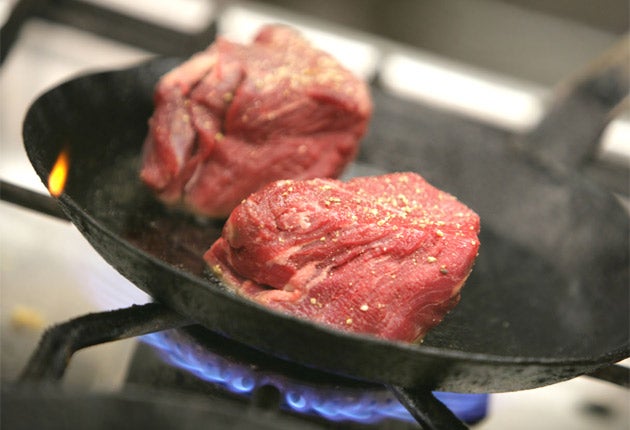Cooking with gas raises risk of lung cancer
Electric hobs release fewer carcinogenic fumes when frying meat, study finds

Your support helps us to tell the story
From reproductive rights to climate change to Big Tech, The Independent is on the ground when the story is developing. Whether it's investigating the financials of Elon Musk's pro-Trump PAC or producing our latest documentary, 'The A Word', which shines a light on the American women fighting for reproductive rights, we know how important it is to parse out the facts from the messaging.
At such a critical moment in US history, we need reporters on the ground. Your donation allows us to keep sending journalists to speak to both sides of the story.
The Independent is trusted by Americans across the entire political spectrum. And unlike many other quality news outlets, we choose not to lock Americans out of our reporting and analysis with paywalls. We believe quality journalism should be available to everyone, paid for by those who can afford it.
Your support makes all the difference.The aroma of seared meat as your pan-fried steak is prepared may set your tastebuds tingling – but it may also give the chef cancer, especially if they are using a gas cooker.
Cooking fumes produced during high-temperature frying are already known to cause cancer. In China, high lung cancer rates among chefs have been linked to the practice of tossing food in a wok, often in a confined space, which increases the concentration of hot oil in the breathing zone of the cook.
The International Agency for Research on Cancer has also classified cooking fumes as "probably carcinogenic". Now researchers from the Norwegian University of Science and Technology in Trondheim have compared gas and electric cooking methods, and found that gas produces higher levels of the cancer-causing fumes.
They measured the fumes produced when frying 17 pieces of steak for 15 minutes each in conditions typical of Western restaurants, using margarine or two different brands of soya oil. The results showed more naphthalene – a banned substance contained in traditional mothballs – and mutagenic aldehydes were produced when cooking with gas. Higher levels of ultrafine particles, which penetrate deeper into the lung, were also produced on the gas hob than on the electric one.
The authors, whose study is published in the journal Occupational and Environmental Medicine, point out that the levels of the chemicals and particulates found in their study were below accepted occupational safety thresholds. But they add that cooking fumes contain other harmful components for which there is no safety threshold, as yet, and which appear to be higher with gas cooking. "Exposure to cooking fumes should be reduced as much as possible," they say.
Cooking fumes are thought to cause lung cancer, as well as cancers of the bladder and cervix. Previous research has found that cancer levels are higher among chefs who did not have fume extractors in their kitchens than among those who did.
Although smoking is the main cause of lung cancer in most countries, in Taiwan only 10 per cent of women with lung cancer smoke. By comparison, 86 per cent of Taiwanese men with lung cancer smoke. Researchers suggest that it is exposure to cooking fumes that accounts for the high rates of lung cancer in women, despite their low smoking rates. A study by researchers from the Institute of Medicine at Kaohsiung University in Taiwan published in the American Journal of Epidemiology in 2000 found that the longer women spent cooking food the higher the risk of lung cancer. Those who cooked on a daily basis had the highest risk. Women who waited until the oil was very hot before cooking the food increased their risk compared with those who cooked at a lower temperature.
Join our commenting forum
Join thought-provoking conversations, follow other Independent readers and see their replies
Comments